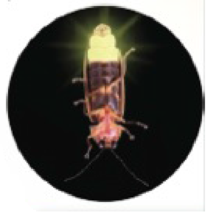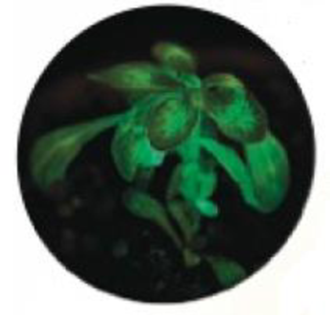
Concept explainers
You may have seen the almost magical glow of fireflies. but did you know that plants can be bioengineered to glow in t he dark, too? The firefly’s natural glow comes from specialized cells in their abdomens that are bioluminescent. meaning that they produce light from biological reactions. These cells are rich in both ATP and the fluorescent chemical luciferin (L. lucifer, light-bringer). Luciferin and ATP serve as substrates for the enzyme luciferase. In the presence of oxygen, luciferase catalyzes a reaction that modifies luciferin, using the energy from ATP to boost electrons briefly into a higher-energy electron shell. As they fall back into their original shell, the electrons emit their excess energy as light.
If Plants Can Glow In the Dark?

Plants don’t naturally glow, but bioluminescence has been bioengineered into glowing Arabidopsis plants by the Glowing Plant team. First, the team ordered commercial luciferin and luciferase DNA synthesized from its computerized gene sequence. Then they implanted these genes into a special form of bacterial DNA that incorporates itself into plant cells. They used a “gene gun” to shoot microscopic particles coated with the modified bacterial DNA into masses of plant stem cells, which developed into plants. Choosing the brightest-glowing plants, the team harvested their seeds to grow new generations, whose seeds are now sold online to buyers who wish to brighten their abodes.

Want to see the full answer?
Check out a sample textbook solution
Chapter 6 Solutions
Biology
- You have discovered a novel peptide that, when administered to plant cells, spontaneously inserts into the thylakoid membranes and forms a channel that lets protons cross the membrane. You treat plant cells growing normally with your peptide. Which of the following statements correctly describes the effect on photosynthesis shortly after the addition of the peptide? Select all that are true. a. The rate of Glyceraldehyde 3-phosphate synthesis will decrease b. The rate of oxygen production will be unaffected c. The rate of Glyceraldehyde 3-phosphate synthesis will increase d. The rate of oxygen production will decrease e. The rate of oxygen production will increase f. The rate of Glyceraldehyde 3-phosphate synthesis will be unaffectedarrow_forwardWhat are the flaws/is wrong ? n photosynthesis, a plant captures light energy and uses it to transform hydrogen and carbon dioxide into glucose and nitrogen. Photosynthesis occurs inside of a chloroplast. A chloroplast is a double membrane bound organelle that is filled with stroma and has stacks of thylakoid disks called grana. Chlorophyll is the pigment in chloroplasts that allow it to capture light and it absorbs all light except green light. Photosynthesis has two main reactions: the light reactions and the Calvin cycle. The light reactions occur in the stroma. Light is captured by photosystem II and is used to split water into hydrogen and oxygen. This release of energy is passed to the electron transport chain to produce ATP. The remaining energy is passed and more light is captured by photosystem I and is used to make NADPH. The ATP and NADPH move into the thylakoid disks and is used in the Calvin cycle. The Calvin cycle has three stages. In carbon fixation, the enzyme RuBisCO…arrow_forwardPhotosynthesis is defined as the chemical process, wherein carbon dioxide in the presence of water and radiant energy gets converted to glucose (chemical energy), giving out oxygen as byproducts. In the equation, the combining reactants and resulting products are expressed along with their respective numbers of molecules. Putting this in a simplified formula, the following equation represents this process. CO2 + H2O + Light energy → C6H12O6 + O2 Considering this equation, how plant lovers (plantitos and plantitas) able to cultivate their plants?arrow_forward
- How is the proton gradient of H+ generated in chloroplasts during photosynthesis? A. Light splits water molecules in the stroma, causing the release of protons. B. Protons are pumped across the thylakoid membrane using energy from ATP. C. Light causes protons to flow through protein channels in the thylakoid membrane. D. The flow of electrons from carrier to carrier in the thylakoid membrane causes the pumping of protons.arrow_forwardIn the light reactions of photosynthesis, electrons within the pigment molecules that are embedded in the plasma membranes of the thylakoids are hit by photons of sunlight. This dramatically increases the energy in these electrons. When photons of light strike electrons in other kinds of molecules, the electrons are raised to high energy levels, but immediately drop back down to their ground states, re-emitting the photons. However, in the light reactions, an excited electron is passed to an electron acceptor molecule before it can drop back down to its ground state. The excited electron is then passed from the primary electron receptor to the electron transport chain and eventually ends up as part of a glucose molecule. If the pigments in the thylakoid are continually passing their electrons to other molecules, how do the pigments replace their missing electrons? To replace the missing electrons, an enzyme removes the two hydrogen atoms from a water molecule.…arrow_forwardPlants undergo both photosynthesis and cellular respiration. Why don’t plants simply use the ATP pro¬duced in the light reactions of photosynthesis to drive cellular processes? A) The ATP produced during photosynthesis is chemically different from the ATP produced during cellular respiration and cannot be used for anabolic reactions B) ATP cannot be stockpiled so the plants would have no energy during non-daylight hours C) The plants have no way of getting the ATP made during photosynthesis out of the chloroplasts to the rest of the cell D) Plants rely on cellular respiration to remove excess O2 and prevent photorespirationarrow_forward
- What are the roles of ATP and NADPH in photosynthesis? a. ATP and NADPH are forms of chemical energy produced from the light dependent reactions to be used in the light independent reactions that produce sugars. b. ATP and NADPH are forms of chemical energy produced from the light independent reactions, to be used in the light dependent reactions that produce sugars. c. ATP and NADPH are forms of chemical energy produced from the light dependent reactions to be used in the light independent reactions that produce proteins. d. ATP and NADPH are forms of chemical energy produced from the light dependent reactions to be used in the light independent reactions that use sugars as reactants.arrow_forwardAs energy passes from blue-absorbing chlorophylls down to red-absorbing chlorophylls, surprisingly, no energy passes from lower energy-absorbing pigments back to higher ones (in other words, the process is irreversible). Why might that be?arrow_forwardWhich of the following statements is FALSE? Group of answer choices: - Plastoquinone has a higher reduction potential than plastocyanin. - Water is the ultimate electron donor. - Proton gradient is created in the light phase of photosynthesis wherein the pH in the stroma is higher than in the lumen. - Photosystem II has chlorophylls in its reaction center that has maximum light absorption at 680 nm.arrow_forward
- Climate monitoring demonstrates a continued increase in carbon dioxide concentration in the atmosphere. Most scientists agree that this increased carbon dioxide will also lead to higher temperatures. a) How might future climate change affect metabolic pathways in plant populations? Explain. b) Biotechnologists are currently looking for ways to maintain food sources in climbing heat and carbon dioxide levels, particularly in developing countries. One such endeavor is to convert rice from a C3 to a C4 pathway to increase its photosynthetic efficiency. Will this actually increase its efficiency? Explain.arrow_forwardWhich statement about the light reactions of photosynthesis and cellular respiration is correct? a. Both reactions occur in the cell cytoplasm b. plants do not require mitochondria because they produce ATP via photosynthesis c. ATP is produced as a result of the actions of an electron transport chain in both processes d. Light reactions and cellular respiration produce the same waste products e. the final electron acceptor in the light reactions is oxygenarrow_forwardBoth NADPH and the related carrier molecule NADH are strong electron donors. Why might plant cells have evolved to rely on NADPH, rather than NADH, to provide the reducing power for photosynthesis?arrow_forward
 Biology: The Dynamic Science (MindTap Course List)BiologyISBN:9781305389892Author:Peter J. Russell, Paul E. Hertz, Beverly McMillanPublisher:Cengage Learning
Biology: The Dynamic Science (MindTap Course List)BiologyISBN:9781305389892Author:Peter J. Russell, Paul E. Hertz, Beverly McMillanPublisher:Cengage Learning
 Biology Today and Tomorrow without Physiology (Mi...BiologyISBN:9781305117396Author:Cecie Starr, Christine Evers, Lisa StarrPublisher:Cengage Learning
Biology Today and Tomorrow without Physiology (Mi...BiologyISBN:9781305117396Author:Cecie Starr, Christine Evers, Lisa StarrPublisher:Cengage Learning


